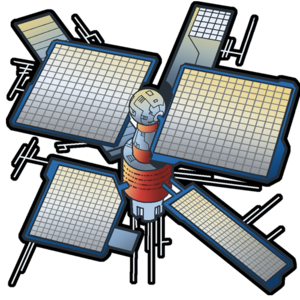Difference between revisions of "Helios Class Solar Satellite"
1424932861 (talk | contribs) |
|||
| Line 3: | Line 3: | ||
The solar satellite is a stationary ship that orbits the planet on which it was built, beaming back down energy. A cheap alternative to the [[Solar Plant]] and [[Nuclear Power Plant]], it provides energy for a good price. | The solar satellite is a stationary ship that orbits the planet on which it was built, beaming back down energy. A cheap alternative to the [[Solar Plant]] and [[Nuclear Power Plant]], it provides energy for a good price. | ||
| − | The major disadvantage to a solar satellite is its vulnerability. Since it is stationary, it cannot be fleet saved. It also takes very little firepower to kill, and every ship in the game has rapid fire against it, making it one of the easiest ships in the game to destroy. | + | The major disadvantage to a solar satellite is its vulnerability. Since it is stationary, it cannot be fleet saved. It also takes very little firepower to kill, and every ship in the game has rapid fire against it, making it one of the easiest ships in the game to destroy. It also makes an attractive target for the salvage of the crystal debris it leaves after a battle. |
==Energy Production== | ==Energy Production== | ||
Revision as of 18:50, 11 March 2010
The solar satellite is a stationary ship that orbits the planet on which it was built, beaming back down energy. A cheap alternative to the Solar Plant and Nuclear Power Plant, it provides energy for a good price.
The major disadvantage to a solar satellite is its vulnerability. Since it is stationary, it cannot be fleet saved. It also takes very little firepower to kill, and every ship in the game has rapid fire against it, making it one of the easiest ships in the game to destroy. It also makes an attractive target for the salvage of the crystal debris it leaves after a battle.
Energy Production
The energy produced by a solar satellite is based on the amount of solar energy received by the planet. This is reflected by the planetary temperature. The more solar energy, the hotter the planet. Thus the output of a solar satellite can be computed from the maximum temperature of the planet, using the following equation:
| Output = | 0.25 * Maximum Temperature | + 20 |
Note: It appears the game rounds this number down to the nearest whole number.
Note that the farther a planet is away from the sun, the cooler it tends to be. Thus solar satellites around planets farther from the sun (e.g. the higher numbered planets) tend to have lower energy output. For instance, a planet 1 in a solar system may yield 41 power from its solar satellites whereas a planet 15 could produce only 8 (these are examples). Obviously, solar satellites produce the same amount of energy for each satellite independent of how many satellites you already have in orbit.
In the case of the coldest known planet (-88°C) the output of the solar satellite is only a meager 4 energy, the hottest known planet (100°C) produces a massive 45 energy.
Statistics
Specifications
Hull Rating: 200
Shield Rating: 1
Weapons Rating: 1
Cargo Capacity: 0
Base Speed: 0
Hydrogen Consumption: 0
Rapid Fire
Against Helios
Charon Class x 0
Zeus Class x 1250
All Others x 5
Requirements
| Capitol 2 | |
| Shipyard 1 | |
| Helios Class Solar Satellite | |
